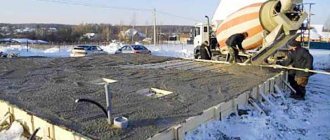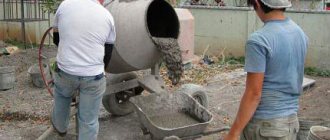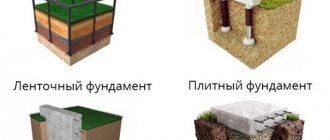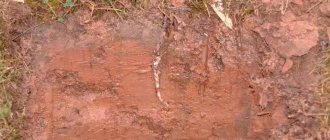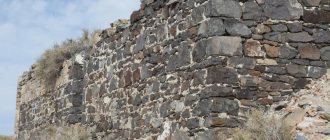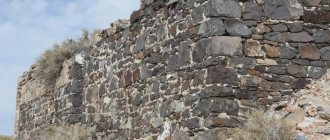Experts agree that winter is not the best time to start construction, which defies logic. After all, it is in winter, due to a decrease in demand, that building materials are much cheaper, and builders who have a lot of free time are ready to take on any job, making a big discount. So why are professionals so categorical in answering the question whether it is possible to pour a foundation in winter?
? Why do experts advise postponing work until spring? Does the quality of a concrete mass depend on the weather conditions prevailing outside the window?
Experts are ready to answer these questions, as well as tell everything related to the impact of temperature conditions on the quality of the concrete mixture. After all, over several years of active activity, we have managed to assemble a team of employees with knowledge, skills, experience, and are also ready to share them with all readers of our blog!
Foundation drying time
How drying time affects the foundation can be understood only by knowing the characteristics of concrete. Here it is necessary to distinguish between the concepts of concrete drying and concrete strength.
Concrete drying is the process of concrete losing moisture. Some kind of dehydration. Concrete gains strength within 30 days from the moment of pouring.
Compressive strength is the main characteristic of concrete. And, as already mentioned, concrete gains it gradually. Concrete gains the first 70% of its brand strength within 7 days. Therefore, it is recommended to disassemble the formwork no earlier than this time.
Concrete strength development timeline
The drying time of the foundation can negatively affect the strength of the entire structure. After all, water actively participates in the processes of strength gain. Since the process of gaining strength takes a long time - up to 30 days, it constantly evaporates. And so that the foundation does not lose strength, it must be watered.
Therefore, it is necessary to prevent the foundation from drying out while gaining strength.
In addition to directly watering the foundation with water, it is necessary to ensure that water does not evaporate from the foundation tape. To do this, the foundation is covered with roofing felt or plastic film.
The nuances of using cement mortar in spring
Builders with experience claim that by starting the construction of the foundation in early spring, there is a chance by the last month of autumn to complete the first stage of building a house under the roof and begin to insulate it for the winter.
They start pouring concrete in the spring, hoping that construction work will be completed faster
Frosts in spring, characterized by a constant drop in temperature below zero, irreversibly change the properties of concrete for the worse. In order for the characteristics of the cement mortar to remain the same, it is recommended to add antifreeze agents to it.
It would not be a bad idea to postpone the work of pouring the foundation until that period of spring, when the weather becomes consistently warm. Usually, already at the end of March, the thermometer shows above-zero temperatures every day.
To pour concrete in the spring, you will have to wait for warm days
After what time can the foundation be loaded?
The time it takes to load the foundation directly depends on the type of building and the material from which the walls will be built. But the most important thing is the setting time of the concrete.
Due to the fact that concrete gains grade strength within 30 days, the logical solution would be to begin loading the foundation no earlier than this time. In practice, for cottage development, the formwork is removed after 7 days, and the construction of walls, that is, loading the foundation, begins no earlier than 21 days from the moment the foundation is poured.
Properties of concrete that benefit builders
When the mixture hardens, a chemical reaction occurs that causes heat. Thanks to this, the concrete dries better, but due to the fact that the ambient temperature is low, no voids are formed in it and it does not dry out. Therefore, the answer to the question whether it is possible to pour the foundation in the fall is unequivocal: yes. The most important thing in this matter is to carefully calculate everything. In addition, pouring concrete must be included in the construction plan; this will allow all the necessary materials, equipment and fixtures to be prepared in advance.
In cold weather it is better not to flood the pillars unless they are sufficiently insulated. Indeed, in such conditions, internal heat will be enough for a very short period of time, during which it will not have time to completely harden. It is better to limit yourself to only a low foundation, in which case the chemical reaction can continue and dry the solution much longer.
After what time can a strip foundation be covered with slabs?
How long does it take to cover a strip foundation with slabs?
If you intend to cover the foundation with floor slabs, then the question of how long to do this is directly similar to the question of the load of the foundation. Therefore, the action plan is the same:
- dismantling of formwork - after 7 days;
- covering with slabs - after 21 days.
Particular attention should be paid to shallow strip foundations built on floating soils. Let's say you poured such a foundation and decided to leave it in the winter.
If such a foundation is left unloaded in the winter, then due to the winter-spring deformation of the soil, a difference in the density of the soil under the foundation will appear. And, as a result, the load resistance in different parts of the foundation slab will be different, which can lead to cracks in the foundation.
Therefore, if you leave such a foundation in the winter, it is recommended to load it at least minimally - remove the base.
What time of year is best to lay the foundation?
Many people are concerned with the question of what time of year is best to pour the foundation. As a rule, the foundation is laid in the fall so that it can settle over the winter. But there are no strict recommendations regarding the time of laying the foundation. The main thing is that the soil is not frozen.
Again, everything has to do with the curing of the concrete. If there are no problems with this in the spring-autumn period, then in winter the water necessary for setting concrete can freeze. Because of this, the concrete does not gain the necessary strength. Antifreeze additives, of course, can save the situation, but still the best time of year to pour the foundation is summer or autumn.
Bottom line
Winter and spring are the most suitable months for purchasing building materials and making arrangements with qualified specialists. In August, foremen advise working on the foundation of the house so that it can settle before the onset of cold weather.
But it’s better to purchase building materials for your home in January, while you can get them at last year’s prices. Also, after the New Year holidays, qualified specialists begin to form orders for the year. Until January, you have time to think about what kind of house you want, convey your ideas to builders and purchase materials at an attractive price.
When is the best time to pour a foundation?
The foundation is the basis of any structure, and the durability of its operation depends on how reliable it is. Mistakes made during pouring the foundation will have a detrimental effect on the integrity of the walls and their strength. That is why it is so important to follow the correct technology for pouring the foundation, doing it in a strictly allotted time.
The best time for this is spring or early summer, when the heat is not yet so high and moisture will not evaporate from the concrete so quickly. In any case, it is important to prevent untimely drying of the concrete mixture, but to follow the technology.
Also, often the process of building a house is delayed until next year, then the foundation must be preserved, which will avoid its premature destruction. Over the winter, a standing foundation without load will stand, settle completely and be ready for the construction of walls.
However, this does not mean that building a house in winter is impossible. Modern construction technologies make it possible to pour the foundation in cold weather, using special additives and devices. The difficulty arises with frozen soil and low temperatures, which cause a lot of inconvenience for the normal hardening of concrete.
Is it possible to pour a foundation in winter?
It is possible to pour a foundation in winter, but special chemical antifreeze additives and timely heating of the concrete allow this to be done. Antifreeze additives prevent moisture in the solution from quickly turning into ice, and heating allows you to delay the time for the concrete to take the strength it needs.
Of course, pouring a foundation in winter is more expensive than in spring or summer. But if there is no way out, then there is nothing left to do but adhere to the technologies and rules that exist today.
Also, a serious disadvantage of pouring a foundation in winter is the impossibility of loading it early. In other words, the foundation must still withstand the allotted time, after which it will be possible to safely continue building the house.
Where do legs grow from?
One famous movie character once said that smart choices come with experience, but stupid choices lead to experience. When everything is done correctly, we sometimes don’t even think about what serious troubles we avoided, but we remember our mistakes for the rest of our lives.
It all started with the construction of a small garden house. The classic strip foundation was chosen. To tell the truth, I didn’t even know about anything else at the time, and it began...
Many people then advised me to pour the foundation before winter, so that for a good quarter of a year the foundation would stand and find its place. Then, they say, not only a house, but an entire house can be built without fear.
No sooner said than done, at least I had to work hard.
First, I cleared the selected area of debris and leveled it in a horizontal plane, and therefore had to take up the shovel even before digging the trench.
Then markings. For this purpose, I hammered pegs into the ground and pulled the lacing along the lines of the future foundation.
But we had to dig a lot. Our freezing depth is more than a meter, and the tape cannot be raised shallower.
Then I put up formwork from the boards, poured out a small sand cushion,
And then I filled everything with homemade concrete grade M 350.
It’s a pity that at that time I was too green, and therefore, after listening to the assurances of my neighbors, I decided not to lay reinforcement in the foundation.
Let me remind you that all this happened in late autumn (oh, damn those advisors) and the first surprises were not long in coming. The frost hit exactly two weeks after pouring, while concrete needs at least 28 days to gain full strength. Not pleasant, right?
No, I knew that in the spring the hardening process would continue, but the result would still not be the same.
After wintering, another “gift” was waiting for me - this is the level, or rather, its complete absence (and I wasted so much time to clearly set the formwork).
“You see,” the friend continued. “And the house could have sunk!”
But the soils were reliable, and the weight of the foundation was not so significant that the difference after subsidence was up to 5 cm.
The enemy came from where they did not expect: frost heaving. I thought that if I put the foundation on non-freezing soil, I would be completely protected from it, but that was not the case.
It turns out that heaving acts on the foundation and through the side walls tangentially, however, these forces are insignificant and cannot lift the entire house, but they are quite capable of handling an unloaded belt. Therefore, the frozen soil twisted the foundation as it wanted. To top it all off, the base cracked in several places.
My “joy,” as you can guess, knew no bounds. How much cement was wasted, and how much labor... But I didn’t want to put a stone building on a defective foundation, and therefore, as soon as the soil melted, I started construction again.
I decided not to touch the old foundation, but simply pour a concrete strip along its outer perimeter. At the same time, the house increased in length and width by almost a meter, but the prospect of digging a concrete monolith out of the ground made me shudder.
Despite the fact that the foundation pit was dug in April and the formwork was installed, I only started concreting in mid-May. The lesson was learned, and therefore I did everything according to science. So, knowing at what temperature concrete sets best (which is 15-20 ° C), I took time so that the thermometer could reach this mark at night.
As for the workflow, some adjustments were also made here.
Firstly, I had to admit that saving on reinforcement is not the best idea, and even though I spent three days tying the reinforcement frame, but lazy people do it twice, and I definitely didn’t want to redo it a third time.
Secondly, I had to give up making my own concrete and buy commercial concrete. The fact is that the foundation needs to be poured not in separate sections, but as a whole and in one day, only then can you count on quality.
And most importantly, thirdly, this time I didn’t delay too much with the construction of the walls. He waited the required four weeks and began laying bricks. By autumn the box was already covered. Therefore, this winter passed without any incidents.
To tell the truth, I sold that vineyard, but the house, as far as I can see, still stands today and I don’t think the owners have ever spent money on repairing the foundation.
What is the connection between the foundation and the time of year?
This connection is relevant for foundations based on concrete, and it is connected with the cycle of formation of artificial stone from mortar. Concrete gains strength gradually as it dries. Further work at this time is limited to tasks not related to the foundation.
The formwork can be removed and construction can continue only after the concrete has gained a certain proportion of its nominal strength (usually 50-70%).
The bottom line is that the installation time of the foundation affects the rate of strength gain, and therefore the amount of forced downtime.
The higher the air temperature, the faster the foundation dries. Therefore, in the summer, when it’s below 30 degrees outside, the formwork from the foundation can be removed in just a couple of days, and construction can continue in a week.
In winter, such a maneuver will not work. At sub-zero temperatures, even after a month the solution will not gain the required strength.
Likewise, the rate of formation of artificial stone is negatively affected by high humidity and precipitation.
Solving the problem of concrete freezing
The next insurmountable problem for builders of past years was that in frost, concrete loses its qualities, becoming brittle. This happens because its components do not mix under such conditions due to crystallization of water due to exposure to frost. Therefore, pouring the foundation in the fall, and even more so in winter, was something unrealistic.
Now everything is solved with the help of chemical additives that prevent water from freezing. In addition, special concrete is sold, which already contains substances that promote its normal hardening at sub-zero temperatures. Its properties are no different from its summer counterpart.
However, there is an opinion that it is undesirable to use chemical additives in the concrete of a residential building, because many of them are poisonous. Therefore, when constructing a building, you need to take this nuance into account.
Also, to pour the foundation, in October or February, it doesn’t matter, salt is added to the solution. Its content should not exceed 2%; it does not allow water to harden. Accordingly, all ingredients are fully mixed and frozen. Without heating, this method can be used down to -5 ° C, and if the temperature drops even lower, then it is worth using heating, which will be discussed later.
You can also make the solution not subject to freezing using acid additives. They are added, after which a chemical reaction occurs in the mixture, which increases the temperature. Under this influence, the concrete dries out. And, of course, in severe frosts, the foundation should be additionally covered so that the generated heat does not immediately evaporate.
What conclusions does this lead us to?
This leads us to the point that we can answer what time of year is best to pour the foundation - when warm and dry weather sets in in your region. For most residents of the temperate zone, these conditions correspond to the end of spring, summer and beginning of autumn.
Should we consider any other factors?
Of course, there are such factors:
- The foundation is poured only after the soil has thawed. Early spring is not suitable, and in some regions, late spring is not suitable.
- The foundation shrinks, so some people prefer to leave it for the winter. With this technology, it is better to pour concrete in early autumn.
- Why not later? Because at this time damp, rainy weather sets in, and the formation of the foundation may not go as planned.
How does concrete hydrate?
People are often interested in when it is possible to pour the foundation in the fall, and whether it is even worth doing it at such an unpredictable time of year. Now let’s look at how concrete hardens in order to better understand all the processes and plan construction accordingly:
- at the initial stage, a crust appears on the surface of the mixture; it is sodium hydrosilicate;
- after this, the harder particles of the foundation surface harden;
- the next stage of solidification is contraction of the shell due to evaporation of the liquid;
- this process begins to move towards the center until the mixture acquires the stated strength.
Based on this diagram and answering the question whether it is possible to pour the foundation in October, experienced builders confidently say: “It is possible!” And we will describe why, comparing this process in summer and autumn-winter.
Is it possible to get rid of seasonality?
Yes, and there are 2 approaches for this:
The first is that you choose a type of foundation that does not involve concrete, such as screw piles. This foundation design is characterized by indifference to climatic conditions during work. Piles are also installed in winter, but in this case difficulties arise with screwing the products into frozen soil.
The second approach involves the use of auxiliary technological means to create ideal climatic conditions on a local scale. An example of such means: heating systems, air guns, insulation of a construction site, the use of special additives to the solution, and so on.
Thus, the answer to the question of what time of year can a foundation be made depends on the type of foundation and the equipment used. For strip foundations in limited conditions of individual construction, it is recommended to carry out work in late summer or early autumn.
There is an opinion that it is cheaper to build in autumn and winter. Do you agree?
Gregory, Ural Federal District. 18 years of experience in construction.
This is true in winter, but in the fall, builders and foremen usually have more work. And the more work, the higher their prices. This continues until the New Year. For example, my work schedule is now scheduled until the end of December. And since January, when construction is suspended, as a rule, workers’ services become cheaper by an average of 10%.
Mikhail, Southern Federal District. 29 years of experience in construction.
In the fall, there is a rush in construction. It is cheaper to build a house in winter. If we talk only about roofing, the real picture is this: at the beginning of the year there is snow, there is little work, products become cheaper, and discounts are offered more often and more. People want to work, but there is not much work as such in the winter. Therefore, the price goes down, and specialists are willing to do the work at a lower price. The movement begins in March, and the active season for roofers lasts from April to December.
Konstantin, Southern Federal District. 18 years of experience in construction.
Those projects that our team completed in the winter were more predictably within the budget. And the delivery deadlines for the material in such cases were always met. During the season, as a rule, there is a rush and prices rise.
